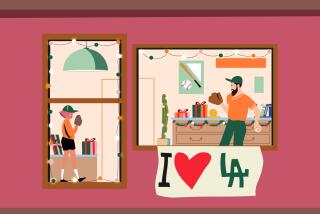AROUND HOME : Notes on Beads and Bees : Baubles and Beads
- Share via
STONE AGE cave dwellers and ‘60s hippies wore them. They were used for money or barter thousands of years before the Indians traded Manhattan for about $24 worth of cloth, trinkets--and beads.
The first beads were probably seeds; since then humans have drilled and threaded and woven beads of bone, shell, wood, nuts, semiprecious stones, metal, glass and plastic. The first gold beads appeared about 3000 BC, and about a thousand years later, in the Greek isles, gold beads were made in the shapes of lilies and lotuses. American Indians stitched their stone-and-shell beads on animal hides, while Africans made entire garments from theirs.
The simplest beadwork is a necklace or bracelet: Beads are threaded, the thread knotted, the wearer adorned. But the selection of beads available today is almost overwhelming. Earthy, oblong, sand-cast beads and glowing amber globes are available. Glass and baked-clay beads are extraordinarily varied and colorful, each one a pattern unto itself. There are sterling silver Afghani beads in the size of a small egg; seed pearls for a wedding veil. Prices range from pennies per bead to thousands of dollars for semiprecious stones and precious metals.
Beads of all kinds can be found at Bead Werk in Santa Monica, Beads Beads in Orange, the Bead Shop in Laguna Beach, Berger Specialty Co. in Los Angeles, and General Bead in San Diego. Ornament magazine, published quarterly, features articles on beads and other ethnic adornment, with lists of sources of supply. Four issues cost $24; order from 1221 S. La Cienega Blvd., Los Angeles 90035.


